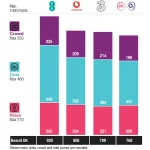Giffgaff Predict UK 5G Mobile Data Use Per User of 100GB by 2025
Mobile operator giffgaff, which harnesses O2’s Mobile Virtual Network Operator (MVNO) platform, has predicted that the future rollout of 5G services within the UK could push their average monthly data usage per user (SIM) from 3.95GB (GigaByes) in 2017 to 98.34GB by 2025.
We should point out that Ofcom’s figure for average data use per 4G (Mobile Broadband) user in the United Kingdom during 2017 was only 1.9GB (here), although that is across all primary Mobile Network Operators (MNO); customers of giffgaff tend to sit at the more data hungry end (Three UK are in a similar boat).
The Operator’s Prediction
Based on the rate of current data usage, we have found that theoretical speed increases will give us a projection of a staggering average monthly data usage of 98.34 GB by 2025, per SIM. The average monthly data usage in 2016 was a mere 1.26 GB, which gives you a real impression of just how much of an impact 5G is going to have.
Our research revealed that the biggest increase in data usage would be the number of people who stream videos on their phones. In 2017, users consumed 0.83 GB’s worth of their data on video streaming; this is expected to rise to 24.76 GB by 2021.
Based on current usage rates, we predict that by 2025, when streaming in 4k will be readily available for mobile users, an amazing 73.87 GB of mobile data per month will be used for video streaming.
We also discovered a trend that firmly suggests the younger you are, the more likely you are to exceed your monthly data allowance. Of all the 18-24 year-olds we surveyed across the UK, 14% said they exceed their mobile data allowance every month.
However we do have the odd issue with giffgaff’s chart. Firstly, it seems to suggest that mobile operators will initially launch 5G services alongside significantly larger data allowances (very probable but not yet confirmed) and that uptake, as well as coverage, will have already achieved significant scale by the end of 2021. Certainly many of the core urban areas may be reasonably well covered by the end of 2021 but uptake tends to be a gradual change.
Advertisement
On top of that the early deployments of any new technology are always less mature and more expensive. In the case of initial 4G rollouts, this meant that consumers didn’t see dramatically faster speeds or usage allowances vs the best 3G services until a little later. A lot of consumers also delayed upgrading until either the prices came down, they changed handset or 4G was adopted as the default vs 3G.
Likewise it has taken years for 4G to reach its initially designed speed aspirations and no doubt 5G will similarly take time to mature, although giffgaff seem to be assuming that 5G “would enable anyone with a compatible device to download at a rate of 10 GB per second” (note to giffgaff: the speeds are measured in Gigabits [Gb] not GigaBytes [GB]).
In reality it will probably be a fair few years before 10Gbps is actually achievable by end-users on a Smartphone under normal conditions. Capacity tends to be shared between many users and, even once matured, you’d struggle to get 10Gbps outside of urban areas. 5G needs a dense network and bands like 23GHz in order to deliver the best speeds, albeit over a short range, which is more intended for fixed wireless links than high mobility or rural environments.
The operator may also be ignoring the potentially huge impact of third-party technology changes, such as the introduction of ever more efficient video streaming and compression (i.e. less speed is needed to deliver the same quality). Having said all that we do expect 5G to deliver a noticeable increase, although it may not be quite as initially dramatic as giffgaff suggest.
Advertisement
Mark is a professional technology writer, IT consultant and computer engineer from Dorset (England), he also founded ISPreview in 1999 and enjoys analysing the latest telecoms and broadband developments. Find me on X (Twitter), Mastodon, Facebook, BlueSky, Threads.net and Linkedin.
« BT Pick Nokia ReefShark Chipset to Fuel Future 5G UK Mobile Network
Court of Appeal Deals Blow to UK ISP Internet Snooping Law »


















































Comments are closed